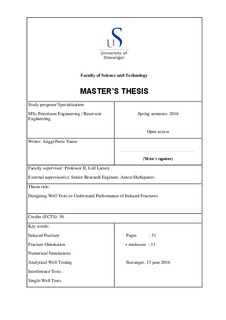| dc.contributor.author | Yanse, Anggi Putra | |
| dc.date.accessioned | 2016-09-21T11:59:11Z | |
| dc.date.available | 2016-09-21T11:59:11Z | |
| dc.date.issued | 2016-06-15 | |
| dc.identifier.uri | http://hdl.handle.net/11250/2409288 | |
| dc.description | Master's thesis in Petroleum engineering | nb_NO |
| dc.description.abstract | Presently, more and more water injection wells operate under induced fracturing condition. Induced fractures geometry and their orientation with respect to the injection well and nearby production wells are crucial factors in determining water injection performance. Designing, conducting and interpreting well tests is a possible way to understand geometry and dynamic behavior of induced fractures. Integrating nearby wells into well testing may give a possibility to characterize induced fracture geometry and its impact on macroscopic sweep efficiency.
In this thesis, one of the objectives is getting knowledge on pressure transient responses of wells connected with fractures with different geometries and orientations using numerical simulations and analytical models. Two scenarios of well tests including single-well tests and interference tests were simulated with two well geometries (vertical and horizontal) and two induced fracture orientations (parallel and perpendicular to the well). Base cases without fracture were simulated and compared with cases including induced fractures. The numerical simulation included injection periods and shut-in periods with similar durations. Synthetic responses generated by the numerical simulation were compared with well test responses from equivalent analytical models. Comparison between the results of all fracture cases for single-well tests and also interference tests were performed and subsequently used to analyse differences in pressure transient responses. Moreover, a comparison of the results of numerical simulations with analytical models was carried out and confirmed capabilities of analytical models in interpreting pressure responses from many cases with various well and fracture geometries.
The analysis of single-well test simulations confirmed that the case with parallel and perpendicular induced fractures intersecting a horizontal well has identical pressure transient responses to the case of induced fracture intersecting a vertical well for cases with high or infinite conductivity. On the other hand, interpretations of the synthetic pressure response generated by simulations of well interference tests indicated different responses in the case with parallel and perpendicular induced fractures: the pressure response to the active well shut-in (or start of injection) was registered later in the observation well in the case of parallel fracture. Therefore, it was confirmed that interference tests can give more information about fracture orientation than single-well tests. Finally, it was shown the value of interpretations of synthetic pressure transients in understanding induced fracture geometry and suggesting a well test design for the field application. | nb_NO |
| dc.language.iso | eng | nb_NO |
| dc.publisher | University of Stavanger, Norway | nb_NO |
| dc.relation.ispartofseries | Masteroppgave/UIS-TN-IPT/2016; | |
| dc.subject | petroleumsteknologi | nb_NO |
| dc.subject | petroleum engineering | nb_NO |
| dc.subject | reservoarteknologi | nb_NO |
| dc.subject | induced fracture | nb_NO |
| dc.subject | fracture orientation | nb_NO |
| dc.subject | numerical simulations | nb_NO |
| dc.subject | analytical well testing | nb_NO |
| dc.subject | interference tests | nb_NO |
| dc.subject | single-well tests | nb_NO |
| dc.title | Designing Well Tests to Understand Performance of Induced Fractures | nb_NO |
| dc.type | Master thesis | nb_NO |
| dc.subject.nsi | VDP::Technology: 500::Rock and petroleum disciplines: 510::Petroleum engineering: 512 | nb_NO |
